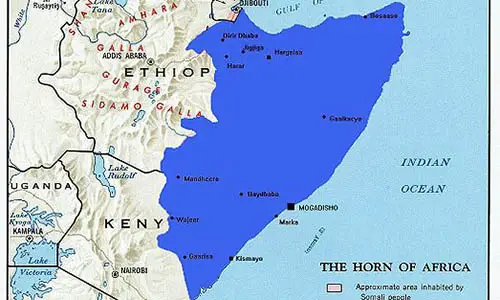1. Two Independence Days
Somalia is a former Italian and British colony that attained independence in 1960. Somaliland region under the British gained independence on 26th June, 1960 while the region under the Italians gained independence on 1st July, 1960. This Horn of Africa country comprises 27 regions. The largest city in Somalia that also serves as its capital city is Mogadishu, also referred to as Xamar.
2. Sunni Muslims
Majority of Somali’s population comprises Sunni Muslims with Sufism and Shia Muslims comprising a smaller percentage. Somalia sits on Africa’s far eastern part and borders the Indian Ocean on the East, Djibouti on the northwest and Kenya on the southwest, Ethiopia to the west and Yemen on the other side of the Gulf of Aden.
3. Language and Currency
The Somali Shilling is the currency that has been used in Somalia since 1962. Arabic and Somalie are the official languages in Somalia. As a semi-arid region, Somalia experiences extremely hot climate. Average annual temperatures range between 20 and 40 degrees Celsius with some areas in the north experiencing temperatures as high as 45 degrees Celsius.
4. British Warplanes
Somalia was the first country in Africa where the British flew warplanes. Today, Somalia is the only country that does not have a stable central government in the world. Somalia is slightly smaller in size than Texas State and has a population of about 10 million people as of July, 2014. 85% of these are of Somali ethnic group while 15% are Bantus and non-Somali groups.
5. Somalis are Homogeneous
Somalis are among the most homogeneous groups in Africa. However, unity in Somalia has been hampered by clan based rivalries with a civil war ending a dictatorship that lasted for 21 years. Since 1991, Somalia has not had a stable government with UN efforts to stop clan based fights between 1992 and 1995 failing. U.S and U.N forces left the country after they suffered high casualties.
6. Somaliland Seceded from Main Somalia
The Republic of Somaliland, which was previously the British Somaliland, seceded from the main Somalia in 1991 and is more prosperous. Hargeysa is its capital with the Berbera port providing access to goods for landlocked Ethiopia. The independence of the Republic of Somalia is widely acknowledged but the international community does not recognize it officially. Instead, efforts to reunite this region with the main Somalia continue.
7. Bloodless Coup and Ethiopian Conflict
After unification of Italian and British Somalilands that gave rise to Somalia in 1960, Mohamed Siad Barre led a bloodless coup in 1969 and became a dictator. Somalia invaded Ethiopia’s Ogaden region between 1977 and 1978. The invasion saw Ethiopian rebels weaken Somalia forces. The two countries have been fighting on occasional basis since 1960. A peace treaty was signed in 1988.
8. Siad Barre’s Exile
In 1991, the United Somali Congress overthrew Siad Barre’s military regime and forced him into exile. A cease fire agreement brokered by Robert Oakley, a US envoy was signed between General Mohammed Farah, a warlord and Ali Mahdi Mohammed, a faction leader.
9. Ship Hijackings and Terror Activities
Ship hijacking activities off the Somalia coast have been going on since 2005. Several UN ships delivering aid and cargo ships from countries such as Ukraine, South Korea, Saudi Arabia and the US have been captured and held for up to 100 days. Demands for ransoms are common for ships to be released. In 2008, the US government identified Al-Shabaab as militant group with al Qaeda links operating in Somalia.
10. Famine in Somalia
The UN declared that Somalia’s Lower Shabelle and Bakool regions were facing famine in 2011. By September the same year, 750,000 people were at risk of imminent starvation. 258,000 people are reported to have died in famine between 2010 and 2012 with 50% of them being children aged below the age of five











Leave a Reply